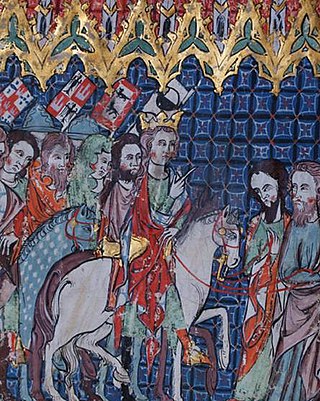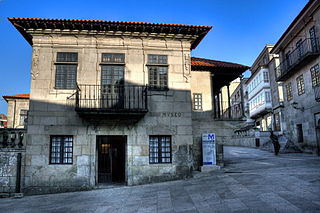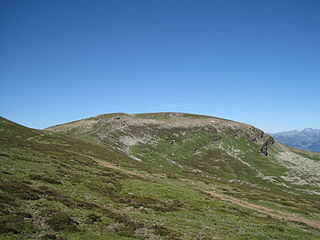
Alfonso XI, called the Avenger, was King of Castile and León. He was the son of Ferdinand IV of Castile and his wife Constance of Portugal. Upon his father's death in 1312, several disputes ensued over who would hold regency, which were resolved in 1313.

Nabisco is an American manufacturer of cookies and snacks headquartered in East Hanover, New Jersey. The company is a subsidiary of Illinois-based Mondelēz International.

Blanca de Castejón was a Puerto Rican actress who is best remembered for her work in the Golden Age of Mexican cinema, especially her award-winning supporting role in Escuela de vagabundos. She was born in Comerío, Puerto Rico, and died in Mexico City.

Aguilar de Campoo is a town and municipality of Spain located in the North of province of Palencia, autonomous community of Castile and León. The River Pisuerga flows through its historic centre. Its 2011 population was 7741.
Peek Freans is the name of a biscuit-making company based in Bermondsey, London, which is now a global brand of biscuits and related confectionery owned by various food businesses. De Beauvoir Biscuit Company owns but does not market in the UK, Europe and USA; Mondelēz International owns the brand in Canada; and English Biscuit Manufacturers owns the brand in Pakistan.

Campoo is a comarca (district) of Cantabria (Spain) located in the High Ebro. With an area of slightly more than 1,000 km2, it includes the municipalities of Hermandad de Campoo de Suso, Campoo de Enmedio, Campoo de Yuso, Valdeolea, Valdeprado del Río, Valderredible, Reinosa, Las Rozas de Valdearroyo, Santiurde de Reinosa, Pesquera, and San Miguel de Aguayo. The local inhabitants are called Campurrians . Its highest elevation is the Cuchillón peak, and the lowest is Pesquera, with the capital, Reinosa at 850 m.
Alberto Fernández Blanco was a Spanish road racing cyclist. His son Alberto Fernández Sainz is also a road racing cyclist.

Juan de Zavala y de la Puente, 1st Marquess of Sierra Bullones was a Spanish noble and politician. After fighting in the First Carlist War, the Marquess served as Prime Minister of Spain.

Galletas Gullón is a Spanish food sector company dedicated to the manufacture of crackers and biscuits. Founded in 1892, in Aguilar de Campoo in the province of Palencia surrounded by wheat fields, Gullón has been the leading producer of biscuits in Spain. In 2009, it had an annual production of 102 million kg and a turnover of 163 million euros and in 2014 with a turnover of 286.6 million euros. Gullón had a turnover of 630 million euros in 2023.

Garci Lasso de la Vega I, also known as "el Viejo" was a Spanish noble in the service of King Alfonso XI of Castile. He was the chancellor of the Kingdom of Castile, an adelantado of the king. He later became the chief justice of the king and gained vast properties in Asturias de Santillana and feudal land tenures and vassal towns in more than fifteen areas throughout Castile. He went to Soria in 1328 to recruit allies against infante Don Juan Manuel who had been consistently violating the king's territories. The Spanish nobles of Soria assaulted him with crossbows, driving de la Vega to seek cover at the Convent of San Francisco where he was eventually killed. Alfonso XI punished all those responsible, ordering their execution.

The La Unión y el Fénix Español building, destined to be the headquarters of the former insurance company "La Unión y el Fénix Español", was one of the first skyscrapers in Madrid. Since 2006 it has housed the "Petit Palace Alcalá Torre" hotel, which belongs to a hi-tech company.
José Alberto Castro is a Mexican producer and director.
Isabel de los Ángeles Ruano is a Guatemalan writer, poet, journalist and teacher. In 1954, she moved with her parents to Mexico; they returned to Guatemala three years later, living in various locations within Jutiapa Department and Chiquimula Department. In Chiquimula, she entered the Instituto Normal de Señoritas de Oriente. She graduated from Educación Primaria Urbana with a teacher's diploma in 1964 at the age 18. In 1966, she traveled on her own to Mexico, where she published her first book, entitled Cariátides, the foreword of the book having been written by the Spanish poet León Felipe. Returning to Guatemala in 1967, she began working in journalism. In 1978, she completed her university studies in Spanish and Latin American Language and Literature at the Universidad de San Carlos de Guatemala. In the late 1980s, she began to suffer from mental disorders. She was awarded the Miguel Ángel Asturias National Prize in Literature by the Ministry of Culture in 2001. Dressing as a man, she has lived for several years in Guatemala City's colonia Justo Rufino Barrios, zona 21.
The Aguilar de Campoo case refers to the disappearance of Virginia Guerrero Espejo and Manuela Torres Bouggefa, two teenaged girls, on April 23, 1992. Guerrero (14) and Torres (13) were last seen hitchhiking from the municipality of Reinosa, Cantabria, to their hometown of Aguilar de Campoo, Palencia. Their disappearance remains unsolved.
The Felipe Trigo Awards are annual literary honors created in 1981 on the initiative of the City Council of Villanueva de la Serena, Spain. On 24 November 1980, the Municipal Assembly agreed to institute it as a tribute to the writer Felipe Trigo, born in the city in 1864.

The Pazo de Castro Monteagudo, is an 18th-century baroque pazo in Pasantería Street, next to the Plaza de la Leña in the city of Pontevedra, Spain, in the heart of the old town.

Terrabusi is an Argentine food brand currently owned by US conglomerate Mondelez International. The former manufacturing company had been founded by the Terrabusi brothers in 1911, and soon gained a reputation as a cookies and crackers manufacturer, commercialising its products under several brands. In 1994, Terrabusi was purchased by U.S.-based company Nabisco, which would be acquired by Philip Morris Companies, Inc. in 2000. As a result, both food companies joined.

The Valdecebollas Peak is an elevation of the Montaña Palentina, in the foothills of the Cantabrian mountain range (Spain), in the orographic knot of La Cebollera, or massif of Valdecebollas. This massif forms a buttress to the south of the Sierra de Híjar, also known on this southern slope as "Sierra de Peña Labra", as this summit is the most characteristic from this perspective.

The Count of Castañeda, ruled by the Counts of Castañeda, a Spanish noble title of late medieval origin, was the first physical territory granted to an aristocrat in the region now occupied by the autonomous community of Cantabria. It initially belonged to the Manrique family. Geographically, it was located in territory originally belonging to the Asturias de Santillana comarca, bordering to the west with the marquisate of Santillana. The nobility title was used for centuries by the eldest sons of the holders of the marquisate of Aguilar de Campoo, first class Grandee of Spain, nowadays, both dignities are separated.














